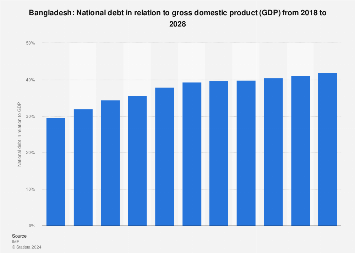Black_cats
ELITE MEMBER

- Joined
- Dec 31, 2010
- Messages
- 10,024
- Reaction score
- -5
Foreign debt soars to $95.71b
Mostafizur Rahman | Published: 23:35, Jun 22,2023https://www.newagebd.net/article/204948/foreign-debt-soars-to-9571b

Bangladesh’s external debt has hit $95.71 billion at the end of March 2023, highlighting its growing reliance on foreign loans to implement its development initiatives.
In just three years, the country’s foreign debt surged by $32 billion, growing from $63.63 billion in March 2020, according to Bangladesh Bank data.
The continuous growth in foreign debt sent per capita debt shooting up to $561.88 from $362.10 in December 2019.
However, the March figure was slightly lower than the $96.5 billion recorded in December 2022.
The foreign debt in March in Bangladeshi currency stood at more than Tk 10,43,269 crore at the rate of Tk 109 a dollar.
The external debt was $72.94 billion in 2020 and $90.79 billion in 2021.
A country’s external debt refers to the total amount of money that the country owes to foreign creditors, such as other countries, international organisations, and foreign private entities. It includes both public and private debt obligations.
Bangladesh usually receives foreign loans from multilateral institutions such as the World Bank, the International Monetary Fund, the Asian Development Bank, the Islamic Development Bank, and major overseas commercial banks.
Bangladesh’s central bank data show that the public sector took $73.53 billion in foreign credit by the end of March 2023, with $61.9 billion borrowed directly by the government and the rest by various government institutions.
Meanwhile, the country’s private sector’s foreign debt declined to $22.18 billion at the end of March from $24.31 billion at the end of December 2022 and $25 billion in March 2022.
The country’s foreign debt has doubled in just six years while the debt was $41.67 billion in 2016, $51.14 billion in 2017 and $57.06 billion in 2018.
The increase in external liability has significant implications, as a considerable portion of the country’s income will be allocated for debt repayment, experts said.
They underscored the need for the country to carefully manage and prioritise its resources to ensure sustainable economic development and avoid excessive dependence on foreign borrowing.
They said that the crisis became worse as local currency was continuously depreciating.
According to Zahid Hussain, former lead economist at the World Bank’s Dhaka office, a critical concern regarding the total external debt lies in the proper use of loans and maximising their output.
He warned that if loans are not effectively utilised in productive sectors, it will pose difficulties in repayment, ultimately leading to a crisis for the country.
Another problem is the lack of new loans as roll-over loans, thereby complicating the loan receiving and payment mechanisms.
Zahid noted that foreign lenders were hesitant to provide loans to the country’s institutions due to a lack of confidence, payment delays, and irregularities.
In order to avert the possible adverse impacts, Zahid emphasised an utmost importance of ensuring a proper use of foreign loans.
Furthermore, he went on to caution, deficits in the financial and current accounts continue to exert pressure on the foreign reserve, ultimately adversely affecting the country’s economic activities.
Bangladesh Bank chief economist Habibur Rahman said that the central bank had taken some measures to contain imports and reduce the pressure on the foreign reserve.
He said that the depreciation of taka was an issue to the foreign debt.
The BB expected that the balance of payment situation and the pressure on exchange rate will continue to improve.
The devaluation of the local currency against the US dollar has made the country’s interest payment against the foreign loans costly.
The Economic Relations Division has calculated that Tk 9,322 crore would be required to clear the interest payment against foreign loans in FY23 as per a revised projection, said finance ministry officials.
The ERD in its projection said that the amount of interest payment against foreign loans would grow further to Tk 12,376 crore in FY24.
The growing imbalance in foreign trade has caused instability in the currency market, with a rise in the interbank dollar rate and a decrease in the foreign exchange reserve.
In July 2021, the exchange rate per dollar in the country was Tk 84.80, which increased to Tk 108 after the central bank allowed the rate to be floating.
The country’s foreign exchange reserve dropped to $30.01 billion on June 21 after reaching a record high of $48.06 billion in August 2021.
The country’s trade deficit was $15.73 billion in the July-April period of FY23 while its import payments stood at $58.78 billion in the first 10 months of FY23.




